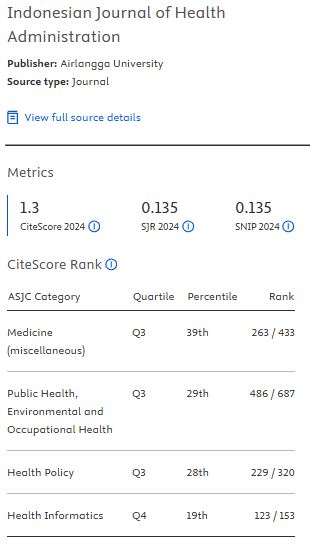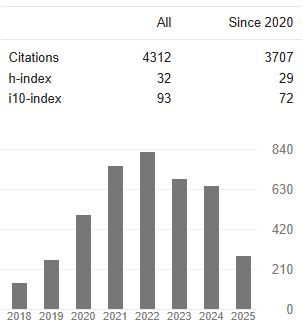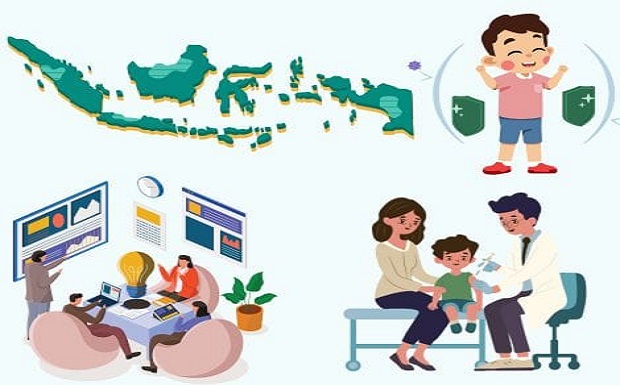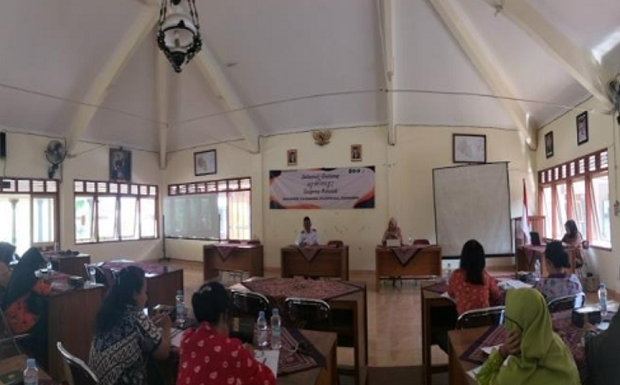DETERMINANTS OF WORK MOTIVATION AMONG DOCTORS AT COMMUNITY HEALTH CENTERS IN INDONESIA

Downloads
Introduction: Effective work motivation among healthcare professionals significantly enhances health service performance and plays a pivotal role in improving service quality.
Aims: This study aims to analyze the determinants influencing work motivation among doctors at community health centers in Indonesia.
Methods: This study employed a quantitative approach with a cross-sectional design, utilizing secondary data from the 2017 Indonesian Workforce Research in the Health Sector. The study sample comprised 9,988 respondents. Logistic regression was employed for data analysis.
Results: In 2017, 55.1% of doctors at community health centers in Indonesia reported high work motivation. Significant correlations were identified between work motivation and various factors: individual characteristics (age, education, marital status, position), intrinsic factors (training and continuing education), extrinsic factors (salary/wages, work area), financial incentives (performance allowances, capitation fund incentives), and non-financial incentives (official vehicles) (p < 0.05). Among these, the type of position was identified as the most dominant factor influencing work motivation (p < 0.05; prevalence ratio (PR) = 1.805 CI 95% [1.608-2.028]).
Conclusion: Work motivation among doctors at community health centers in Indonesia is significantly influenced by individual characteristics, intrinsic and extrinsic factors, as well as financial and non-financial incentives, with the type of position being the most dominant factor. To enhance motivation and improve healthcare services, policymakers should strengthen career development, expand training opportunities, improve financial and non-financial incentives, and implement targeted retention strategies, especially in underserved areas.
Keywords: Community health center, doctor, Indonesia, work motivation
Afolabi, A., Fernando, S., and Bottiglieri, T. (2018). Factors in Motivating Healthcare Employees : a Systematic Review. British Journal of Healthcare Management, 24(12), 603–610.
Anita, B., Febriawati, H., and Yandrizal, Y. (2016). The Role of Public Health Centers (Puskesmas) as the Gatekeeper of National Health Insurance. Jurnal Kesehatan Masyarakat, 12(1), 76–89. https://doi.org/10.15294/kemas.v12i1.3933
Agyepong, I. A., Anafi, P., Asiamah, E., Ansah, E. K., Ashon, D. A., and Narh‐Dometey, C. (2004). Health worker (internal customer) satisfaction and motivation in the public sector in Ghana. The International journal of health planning and management, 19(4), 319-336.
Ankomah, S., Kumah, E., and Karikari, A. K. (2016). Health Worker Motivation in Ghana: The Role of Non-Financial Incentives. A Case Study of Accident and Emergency Department of Komfo Anokye Teaching Hospital Data Quality challenges with district health information management system 2 in the westen region. 6(4), 34–49.
Chimwaza, W., Chipeta, E., Ngwira, A., Kamwendo, F., Taulo, F., Bradley, S., and McAuliffe, E. (2014). What makes staff consider leaving the health service in Malawi? Human Resources for Health, 12(1), 1–9. https://doi.org/10.1186/1478-4491-12-17
Chmielewska, M., Stokwiszewski, J., Filip, J., and Hermanowski, T. (2020). Motivation factors affecting the job attitude of medical doctors and the organizational performance of public hospitals in Warsaw, Poland. BMC Health Services Research, 20(1), 1–12. https://doi.org/10.1186/s12913-020-05573-z
Dagne, T., Beyene, W., and Berhanu, N. (2015). Motivation and Factors Affecting It among Health Professionals in the Public Hospitals, Central Ethiopia. Ethiopian Journal of Health Sciences, 25(3), 231–242. https://doi.org/10.4314/ejhs.v25i3.6
Daneshkohan, A., Zarei, E., Mansouri, T., Maajani, K., Ghasemi, M. S. iyaha., and Rezaeian, M. (2015). Factors affecting job motivation among health workers: a study from Iran. Global Journal of Health Science, 7(3), 153–160. https://doi.org/10.5539/gjhs.v7n3p153
Deci, E. L., and Ryan, R. M. (2013). Intrinsic motivation and self-determination in human behavior. Springer Science and Business Media.
Essi, G. (2017). Hubungan Disiplin, Motivasi Kerja Dan Pembagian Insentif Dana Kapitasi Program Jaminan Kesehatan Nasional Terhadap Kinerja Pegawai Puskesmas Alai Kota Padang Tahun 2017 (Doctoral Dissertation, Universitas Andalas).
Ghimire, J., Gupta, R. P., Kumal, A. B., Mahato, R. K., Bhandari, R. M., and Thapa, N. (2013). Factors associated with the motivation and de-motivation of health workforce in Nepal. Journal of Nepal Health Research Council, 11(24), 112–118.
Global Health Workforce Alliance. (2014). Report of Third Global Forum on Human Resources for Health, Recife, Brazil.
Grujičić, M., Bata, J. J., Radjen, S., Handoyo, N. E., Prabandari, Y. S., and Rahayu, G. R. (2018). Identifying motivations and personality of rural doctors: A study in Nusa Tenggara Timur, Indonesia. Education for Health, 31(3), 174-177.
Hertzberg, F., Mausner, B., and Snyderman, B. (1959). The motivation to work. New York.
Ibeziako, O. J., Chabikuli, O. N., and Olorunju, S. (2013). Hospital reform and staff morale in South Africa: A case study of Dr Yusuf Dadoo Hospital. South African Family Practice, 55(2), 180–185. https://doi.org/10.1080/20786204.2013.10874330
Kaoje, A. U., Magaji, B. A., Raji, M. O., Oladigbolu, R. A., Mohammed, M. B. K., Sani, M., and Yahya, Z. B. (2019). Predictors of job motivation among doctors and nurses in a tertiary hospital in Sokoto , Nigeria. 6(4), 1385–1392.
Karaferis, D., Aletras, V., Raikou, M., and Niakas, D. (2022). Factors Influencing Motivation and Work Engagement of Healthcare Professionals. Materia Socio-Medica, 34(3), 216–224. https://doi.org/10.5455/msm.2022.34.216-224
Laksono, A. D., Wulandari, R. D., and Soedirham, O. (2019). Regional disparities of health center utilization in rural Indonesia. Malaysian Journal of Public Health Medicine, 19(1), 158–166.
Lambrou, P., Kontodimopoulos, N., and Niakas, D. (2010). Motivation and job satisfaction among medical and nursing staff in a Cyprus public general hospital. Human resources for health, 8, 1-9. https://doi.org/10.1186/1478-4491-8-26
Maharanti, S., Soedarso, S., Asmita, P., and Susanna, D. (2018). The Working Motivation of Doctors in the Era of National Health Insurance in Ngesrep Primary Health Care (PHC) 2015. KnE Life Sciences, 4(4), 311. https://doi.org/10.18502/kls.v4i4.2290
Manyazewal, T. (2017). Using the World Health Organization health system building blocks through survey of healthcare professionals to determine the performance of public healthcare facilities. Archives of Public Health, 75(1), 1–8. https://doi.org/10.1186/s13690-017-0221-9
Ministry of Health of the Republic of Indonesia. (2022). Tenaga Kesehatan Sebagai Ujung Tombak Keberhasilan Implementasi Transformasi Kesehatan.
Momanyi, G. O., Adoyo, M. A., Mwangi, E. M., and Mokua, D. O. (2016). Value of training on motivation among health workers in Narok county, Kenya. Pan African Medical Journal, 23, 1–12. https://doi.org/10.11604/pamj.2016.23.261.8414
Mutale, W., Ayles, H., Bond, V., Mwanamwenge, M. T., and Balabanova, D. (2013). Measuring health workers’ motivation in rural health facilities: Baseline results from three study districts in Zambia. Human Resources for Health, 11(1), 1–8. https://doi.org/10.1186/1478-4491-11-8
Noya, F. C., Carr, S. E., and Thompson, S. C. (2022). Commitments, Conditions and Corruption: An Interpretative Phenomenological Analysis of Physician Recruitment and Retention Experiences in Indonesia. International Journal of Environmental Research and Public Health, 19(9). https://doi.org/10.3390/ijerph19095518
Nurcahyo, H., and Bachtiar, A. (2020, February). Analysis of the problems of general practitioners distribution in community health centers (Puskesmas) in Indonesia. In 4th International Symposium on Health Research (ISHR 2019) (pp. 354-360). Atlantis Press.
Novaković, B., and Grujičić, S. Š. (2016). Radna motivacija i zadovoljstvo poslom zdravstvenih radnika u urbanim i ruralnim sredinama. Vojnosanitetski Pregled, 73(8), 735–743. https://doi.org/10.2298/VSP140715062G
Nyambegera, S. M., and Gicheru, C. N. (2016). Extrinsic and Intrinsic Factors Influencing Employee Motivation: Lessons from AMREF Health Africa in Kenya. International Journal of Business and Social Research, 6(9), 20. https://doi.org/10.18533/ijbsr.v6i9.985
Ojakaa, D., Olango, S., and Jarvis, J. (2014). Factors affecting motivation and retention of primary health care workers in three disparate regions in Kenya. Human Resources for Health, 12(1), 33. https://doi.org/10.1186/1478-4491-12-33
Okafor, I. P., Dada, A. A., Olubodun, T., and Olufunlayo, T. F. (2022). Health worker motivation to deliver quality care in western Nigeria. IJQHC Communications, 2(2), 1–8. https://doi.org/10.1093/ijcoms/lyac012
Oxholm, A. S., Gyrd-Hansen, D., Jacobsen, C. B., Jensen, U. T., and Pedersen, L. B. (2024). The link between physician motivation and care. The European Journal of Health Economics, 25(3), 525-537. https://doi.org/10.1007/s10198-023-01605-7
Purohit, B., and Bandyopadhyay, T. (2014). Beyond job security and money: driving factors of motivation for government doctors in India. Human Resources for Health, 12, 12. https://doi.org/10.1186/1478-4491-12-12
Renganathan, E., and Davies, P. (2023). Sustainable Development Goals and the role of and implications for primary care physicians. Malaysian Family Physician: the Official Journal of the Academy of Family Physicians of Malaysia, 18, 54.
Sarriot, E., Davis, T., Morrow, M., Kabore, T., and Perry, H. (2021). Motivation and Performance of Community Health Workers: Nothing New Under the Sun, and Yet... Global Health Science and Practice, 9(4), 716–724. https://doi.org/10.9745/GHSP-D-21-00627
Sato, M., Maufi, D., Mwingira, U. J., Leshabari, M. T., Ohnishi, M., and Honda, S. (2017). Correction: Measuring three aspects of motivation among health workers at primary level health facilities in rural Tanzania (PLoS ONE (2017) 12:5 (e0176973) DOI: 10.1371/journal.pone.0176973). PLoS ONE, 12(9), 1–17. https://doi.org/10.1371/journal.pone.0184599
Shah, S. M., Zaidi, S., Ahmed, J., and Rehman, S. U. (2016). Motivation and Retention of Physicians in Primary Healthcare Facilities: A Qualitative Study From Abbottabad, Pakistan. International Journal of Health Policy and Management, 5(8), 467–475. https://doi.org/10.15171/ijhpm.2016.38
Shah, S. M., Zaidi, S., Ahmed, J., and Ur Rehman, S. (2016). Motivation and retention of physicians in primary healthcare facilities: A qualitative study from Abbottabad, Pakistan. International Journal of Health Policy and Management, 5(8), 467–475. https://doi.org/10.15171/ijhpm.2016.38
Tuoi, D. T., and Phong, H. N. (2023). Determinants Influencing on the Working Motivation of Doctors in Public Hospitals in Hanoi. International Journal of Multidisciplinary Research and Analysis, 06(03), 1220–1227. https://doi.org/10.47191/ijmra/v6-i3-44
Wang, H., Zhao, S., Liu, Q., Wang, J., and Yuan, B. (2022). The Association Between Financial Incentives and Job Performance Among Primary Care Providers in Six Provinces of China. Risk Management and Healthcare Policy, 15, 2323–2334. https://doi.org/10.2147/RMHP.S384114
Wáng, Y.-X. J., Káplár, Z., and L, Y. T. (2015). AME survey-003 A1-part 2: the motivation factors of medical doctors in China. Quantitative Imaging in Medicine and Surgery, 5(6), 917–924. https://doi.org/10.3978/j.issn.2223-4292.2015.12.01
Weldegebriel, Z., Ejigu, Y., Weldegebreal, F., and Woldie, M. (2016). Motivation of health workers and associated factors in public hospitals of West Amhara, Northwest Ethiopia. Patient Preference and Adherence, 10, 159–169. https://doi.org/10.2147/PPA.S90323
World Bank. (2020). Physicians (per 1,000 people) Indonesia.
World Health Organization. (2016). Health workforce requirements for universal health coverage and the Sustainable Development Goals: Human Resources for Health Observer Series No 17.
World Health Organization (2016). Global strategy on human resources for health: Workforce 2030. Who, 64.
Xu, L., Wang, Z., Li, Z., Lin, Y., Wang, J., Wu, Y., and Tang, J. (2022). Mediation role of work motivation and job satisfaction between work-related basic need satisfaction and work engagement among doctors in China: a cross-sectional study. BMJ Open, 12(10), 1–10. https://doi.org/10.1136/bmjopen-2021-060599
Weldegebriel, Z., Ejigu, Y., Weldegebreal, F., and Woldie, M. (2016). Motivation of health workers and associated factors in public hospitals of West Amhara, Northwest Ethiopia. Patient preference and adherence, 159-169. https://doi.org/10.2147/PPA.S90323
Copyright (c) 2025 Rusdiana Rusdiana, Achmad Fickry Faisya, Haerawati Idris

This work is licensed under a Creative Commons Attribution-ShareAlike 4.0 International License.
1. As an author you (or your employer or institution) may do the following:
- make copies (print or electronic) of the article for your own personal use, including for your own classroom teaching use;
- make copies and distribute such copies (including through e-mail) of the article to research colleagues, for the personal use by such colleagues (but not commercially or systematically, e.g. via an e-mail list or list server);
- present the article at a meeting or conference and to distribute copies of the article to the delegates attending such meeting;
- for your employer, if the article is a ‘work for hire', made within the scope of your employment, your employer may use all or part of the information in the article for other intra-company use (e.g. training);
- retain patent and trademark rights and rights to any process, procedure, or article of manufacture described in the article;
- include the article in full or in part in a thesis or dissertation (provided that this is not to be published commercially);
- use the article or any part thereof in a printed compilation of your works, such as collected writings or lecture notes (subsequent to publication of the article in the journal); and prepare other derivative works, to extend the article into book-length form, or to otherwise re-use portions or excerpts in other works, with full acknowledgement of its original publication in the journal;
- may reproduce or authorize others to reproduce the article, material extracted from the article, or derivative works for the author's personal use or for company use, provided that the source and the copyright notice are indicated.
All copies, print or electronic, or other use of the paper or article must include the appropriate bibliographic citation for the article's publication in the journal.
2. Requests from third parties
Although authors are permitted to re-use all or portions of the article in other works, this does not include granting third-party requests for reprinting, republishing, or other types of re-use.
3. Author Online Use
- Personal Servers. Authors and/or their employers shall have the right to post the accepted version of articles pre-print version of the article, or revised personal version of the final text of the article (to reflect changes made in the peer review and editing process) on their own personal servers or the servers of their institutions or employers without permission from JAKI;
- Classroom or Internal Training Use. An author is expressly permitted to post any portion of the accepted version of his/her own articles on the author's personal web site or the servers of the author's institution or company in connection with the author's teaching, training, or work responsibilities, provided that the appropriate copyright, credit, and reuse notices appear prominently with the posted material. Examples of permitted uses are lecture materials, course packs, e-reserves, conference presentations, or in-house training courses;
























